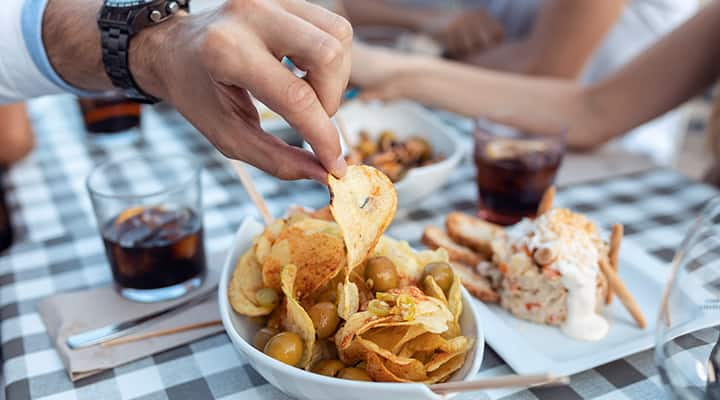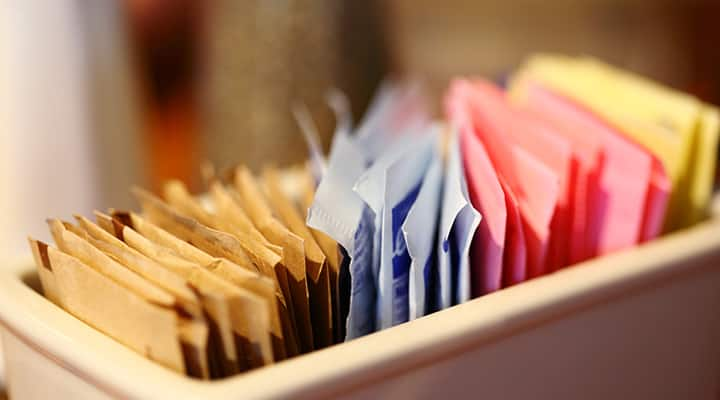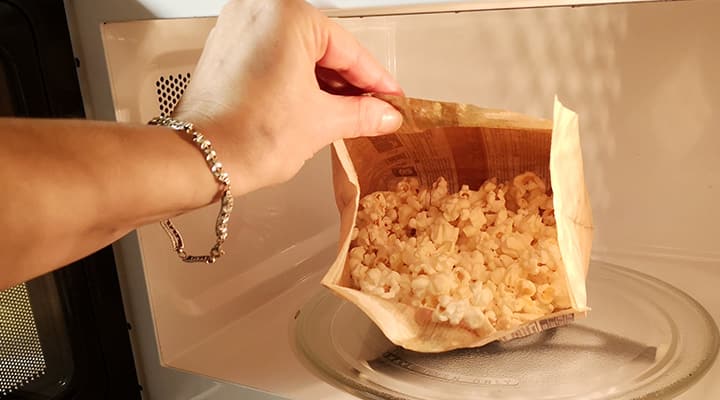While there is some sound reasoning and truth to this, it’s not a fool proof method. For one thing, the bakery section is usually in the perimeter! For another, you will find some healthy options for your pantry smack in the middle of the store, such as nuts, canned tuna, beans and vegetables, and spices.
And let’s also consider the fact that it’s just not practical to ignore anything and everything with a shelf life! In today’s modern and fast-paced world, packaged foods have become part of our lives and avoiding anything in a package is nearly impossible for the average person.
The good news is that we also have many options for healthy foods located all over the grocery store. Since ingredients can vary significantly by brand, you’ll need to compare and contrast by looking at both the nutrition facts and ingredient list on the label to figure out which is the “lesser evil” when you do venture into those middle aisles.
What are processed foods?
Unless you are picking your own berries in the Alaskan wilderness, for example, chances are that your food has gone through some level of processing. But did you know that there are different levels of processing? We can break down the definitions as follows:
- Unprocessed foods include freshly picked fruits and vegetables.
- Minimally processed foods or ingredients include things like nuts and dried fruits.
- Processed foods include store-bought bread and cheese but also canned fish and fruit in syrup. It may come as a surprise that bread is considered a processed food—but indeed it is, according to definitions from the NOVA Food Classification system.
- Ultra-processed foods (UPFs), more commonly known as junk food, are foods that are hyper-palatable (very pleasing to the taste buds) and often high in sugar, salt, fat, calories, or all of these. Not only that—these ultra-processed foods often contain a variety of additives. Fast food, soft drinks, lollies, chips and other packaged snacks may come to mind, but also some other things like flavoured sugary yogurt, margarine, frozen meals, baked goods, and breakfast cereals are considered ultra-processed.
Are processed foods bad for you?
Minimally processed foods and some processed foods are fine—the ultra-processed foods (UPFs) give me pause as a Functional Medicine Practitioner.. Will a single mars bar or Big Mac be your undoing? No. But if your diet contains heavy amounts of foods with added sugar and other questionable nutrients, yes, this is unhealthy. Why? Let’s start with the obvious: processed foods tend to be high in empty calories and are considered a contributor to the obesity epidemic.
But obesity is only one of the health problems associated with a highly processed diet. Ultra-processed foods may speed cognitive decline; according to a study presented at the Alzheimer’s Association International Conference 2022, people who eat large amounts of ultra-processed foods have a faster decline in cognition. Researchers studied 10,775 people over eight years and found that high consumption (more than 20% of daily intake) of ultra-processed foods led to a 28% faster decline in global cognitive scores, including memory, verbal fluency and executive function. High intake of these UPF’s are also linked to inflammation, cancer, poor dental health, microbiome imbalances, behavioural problems, sleep disturbances, endocrine system disruption, heart problems…and the list goes on.
10 ingredients to avoid in processed food
When it comes to additives, a common theme has been that most things are not harmful in small amounts, which is why it’s important to limit processed foods and have a varied diet. The 10 ingredients on this list are OK to have on occasion; if they’re part of your daily bread (or literally in your daily bread), you should consider swapping them out for less processed options.
1. Hydrogenated and trans fat
Vegetable and seed oils from soybean, canola, corn, cottonseed and more are widely used in the Australia food system from use in ultra-processed foods to home cooking or culinary use. The types of polyunsaturated fats, including omega-6, found in vegetable oils are unstable. Therefore, the food industry alters the chemical structure of these oils to make them more stable, a process called hydrogenation. This process aids in the development of artificial trans fats, a type of fat that is detrimental to health.
While there are some regulations into place against the use of artificial trans fats, hydrogenated oils are still widely found in foods such as margarines, shortenings, biscuits, pie crust, shelf-stable pastries, tortillas, crackers, and more. Overconsumption of omega-6 fats from vegetable oils paired with under consumption of omega-3 fats can contribute to inflammation and poor health.
2. High fructose corn syrup (HFCS)
HFCS is a sweetener made from corn and is widely used in ultra-processed foods. Due to the abundant use of HFCS in many packaged foods, it makes it easy for consumers to get too much. Like sucrose (table sugar), HFCS is comprised of glucose and fructose (which is the sweetest of all sugars); however, HFCS has a slightly higher ratio of fructose, whereas table sugar is 50/50. This becomes important because fructose is metabolized differently than glucose and excess fructose from processed foods can be problematic for liver health. Ultimately, HFCS is another source of added sugar in the diet to watch out for.
A clinical study of 85 participants found a dose-dependent association between high fructose corn syrup intake and increased liver fat and worsened glucose parameters, suggesting a contribution to the development of non-alcoholic fatty liver disease and type 2 diabetes.
3. Artificial colours
I always recommend people to “eat the rainbow” but when I give this advice, I am talking about a wide array of brightly coloured fruits and vegetables. I am not referring to artificial colours widely found in candy, cereal, and other foods where you wouldn’t even expect artificial colour to be used (check your labels, you’ll be surprised where dyes are hiding!). Red 40, and yellow 5 and 6 are common dyes used to add a more pleasing colour to our foods.
Are they bad for our health? The research is inconsistent, so the verdict is still out. While behavioural problems such as ADHD have been linked to consumption of artificial colours, these food colourings have not been established as a cause; but, some studies suggest they may make these problems worse.
Other concerns include allergic reactions to dyes and the potential for contaminants that can be found in dyes as well. If you want to err on the side of caution, you’ll probably be doing yourself a favour by avoiding foods with artificial colours because the foods that they are found in are often processed foods that have other ingredients to be avoided anyway. For cooking, colours can be made from turmeric, beets, blueberries, cherries, and other boldly coloured foods where these hues naturally occur.
4. Added sugar
At this point it is well known that high sugar intake is bad for us. But it’s not just the sugar we add to our baked goods or coffee that we need to be monitoring. It’s important to note that packaged foods and beverages are a major contributor to high sugar intake. Even foods that are generally nutritious, like yogurt, can contain too much sugar. Be sure to look at the nutrition facts breakdown where you will find how much accounts for added sugar specifically.
5. Artificial sweeteners
So we know that we should be cutting back on sugar, but artificial sweeteners have their own “baggage”—and some of it is serious. In a large cohort study including over 100,000 people, people who consumed high amounts of artificial sweeteners had a higher overall risk of cancer compared to non-consumers. In particular, aspartame and acesulfame-K were associated with increased cancer risk. Plus, artificial sweeteners may also contribute to imbalanced gut health (dysbiosis). In addition to avoiding aspartame and acesulfame-K, watch out for saccharin and sucralose.
Not sure which one of these is in your packet of choice at your local café? Determine which sweetener that brand uses with a quick google search. There are some natural alternatives to sugar that are safe to use if you’re looking for a sugar-free option; xylitol and stevia are good choices.
Are Processed Foods Addictive?
If it’s hard to have just one cookie or a few chips, does that mean these foods are “addictive”? Perhaps. However, an “addiction” to food that’s been processed is not quite the same as an addiction to drugs or alcohol. Human studies have found a strong association with sugary foods and strong cravings, suggesting that ultra-processed foods can stimulate certain “reward” centres of the brain. These foods are sometimes referred to as “hyperpalatable” food because they have enjoyable qualities such as sweetness or saltiness. And when people suddenly stop eating them, it’s common for them to feel the opposite of a reward, namely anxiety and stress, or even withdrawal symptoms. A review of clinical trials looking at highly palatable sugary foods and negative emotions found that sugar can change brain chemistry and may have addictive effects. However, complex carbohydrates can help with serotonin production, a “feel good” neurotransmitter which is influenced by food and alcohol intake.
6. Nitrites/nitrates
Nitrates and nitrites occur naturally in water and soil (and therefore, food, including veggies!) but are also used as preservatives in processed meats to keep the meat from turning brown and to prevent bacterial growth. No one wants to eat bad meat, so what’s the problem? After reviewing hundreds of studies, the World Health Organization has determined that processed meats such as hot dogs can increase our risk of colorectal cancer. In fact, the WHO has even classified processed meats as a carcinogen, a substance that promotes the formation of cancer. Plus, a recent meta-analysis of 41 articles suggests that nitrate/nitrite intake is associated with site-specific cancer. Risk of glioma, bladder, and stomach cancer were increased with higher nitrite intakes. Thyroid cancer risk was higher with higher nitrate intakes. Another study showed that food nitrates and nitrites are positively associated with breast and prostate cancer risks.
So, if nitrites/nitrates are also in vegetables and other foods that grown in soil, why aren’t vegetables part of the problem and on the WHO’s list of carcinogens? As usual, there’s more to this story. The nitrites/nitrates found in vegetables are less likely to form related compounds called nitrosamines. In processed meats, it’s the nitrites’ proximity to a higher amount of amino acids from protein, plus being cooked at high temperatures, that create cancer-causing nitrosamines and advanced-glycated end products.
7. Monosodium glutamate (MSG)
This flavour enhancer, often associated with its use in Chinese food because of its umami (savoury) taste, can also be found in the popular brand of nacho flavoured triangular tortilla chips. On the bag, you’ll find it listed under the ingredients by its full name: monosodium glutamate. Despite being generally recognized as safe (GRAS) by the FDA, some researchers have linked extensive use of MSG to disruptions of the central nervous system, fat tissue, liver function, and more. Also, some individuals in particular are sensitive to MSG and should avoid it.
8. Synthetic preservatives
Preservatives in foods can be natural, such as rosemary extract. But the synthetic ones are on my “avoid” list. BHA/BHT and TBHQ are synthetic compounds with antioxidant properties, used to help prevent oils and fats from oxidizing, for example. While both the FDA and international agencies recognize it as safe when consumed in levels allowed in foods, there are some reports that BHT can affect sleeping, induce changes in serotonin and norepinephrine, and some consider it to be an endocrine disruptor. You’re better off opting for foods with a shorter shelf life.
9. Artificial flavours
You’ll find artificial flavours widely used in ultra-processed foods to enhance both the flavour and aroma. One example is diacetyl, an artificial butter flavouring. The cautionary story of “popcorn lung” stems from the use of this ingredient in the production of microwavable popcorn. Inhalation of high levels of diacetyl led popcorn factory workers to develop lung disease. The butter-like flavour has also been linked to Alzheimer’s disease in lab animals. In 2018, the FDA removed 7 artificial flavoring substances from the food additives list – 6 of them because they caused cancer in lab animals. The good news is that companies usually disclose artificial flavouring right on the front of the label, so if you want to avoid these additives, it shouldn’t be too tricky if you’re a discerning shopper.
10. Excessive sodium
Sodium is an essential mineral that plays an important role as an electrolyte in the body and impacts cellular function, heart health, our nervous system, and more. Just as too much of bad thing is no good, too much of a good thing can be a real problem. Sodium (a component of table salt) is used in large quantities in the production of processed foods not only to add flavour but as a preservative among other functions. Australians consume on average 3,400 milligrams (mg) of sodium per day—nearly 50% more than the 2,300 mg limit recommended by federal guidelines for people 14 years and older, much of which comes from packaged and prepared foods.
How to cut out processed foods in a healthy diet?
If you’re sold on reducing the processed foods from your diet, it’s pretty easy to make small changes to how you shop and prepare food. Start with these tips:
- Discerning deli shopping: Choose “off the frame” sliced meats instead of those that have been cured.
- Be a baker: Make your own tortilla shells and baked goods.
- Read labels: Read the nutritional facts and ingredient list. Keep a close eye on added sugars and sodium in particular, and compare brands rather than just tossing your favourite in the shopping cart.
- Play the numbers game: Choose packaged goods that have 3-5 ingredients—or less!
- Make a lifestyle change: Follow the Mediterranean or flexitarian diet, both of which will naturally steer you towards unprocessed foods, with their emphasis on fruits and vegetables and whole grains.
- Stay in balance: Make sure you are getting enough omega-3, as this nutrient helps balance out the more harmful omega-6 fatty acids found in processed foods.
- Opt for EVOO: Choose extra-virgin olive oil and avocado oil over other vegetable oils.
- Be colourful: Eat foods that provide colour naturally, like brightly coloured fruits and vegetables, which are rich in flavonoids—and flavour!
- Pass on the packets: Avoid those sweeteners you see at restaurants and cafes.






“Shop the perimeter of the grocery store.” Have you heard this tip before? The theory is that the fresher foods such as the seafood, meats and poultry, dairy, and produce are located around the perimeter, while the boxed, canned, and otherwise packaged foods—aka, the less wholesome and “empty” calorie choices—are within the central aisles.